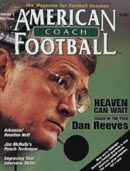AMERICAN FOOTBALL MONTHLY THE #1 RESOURCE FOR FOOTBALL COACHES
Article CategoriesAFM Magazine
|
Reconditioning Football Equipment.Safety beyond the shine and polish.by: Will Rodecap Head Equipment Manager,Colorado State University © More from this issue Do you ever reach the end of the season and wonder what to do with your reconditioning? It does not have to be guesswork or a hassle. Consider the following pointers before sending your equipment in for service. Helmets With all the legal, liability and safety issues surrounding your players, the proper care of this piece of equipment is probably more important than any other. It is important to know that both Riddell and Schutt require that their helmets be reconditioned and recertified every other year on all varsity helmets. If the helmet is serviced by an approved reconditioner, the manufacturer will replace the shell if it cracks or is defective within the five-year window of the warranty period. By checking your existing inventory, you can determine what needs to be reconditioned and what can be held ba....The full article can only be seen by subscribers.
|
|
|||||||
| HOME |
MAGAZINE |
SUBSCRIBE | ONLINE COLUMNISTS | COACHING VIDEOS |
Copyright 2025, AmericanFootballMonthly.com
All Rights Reserved





